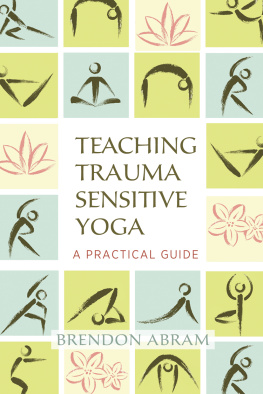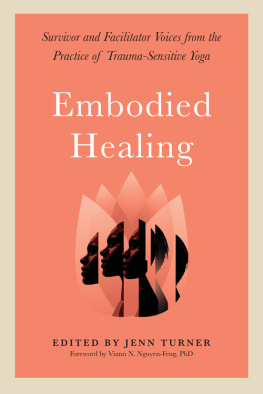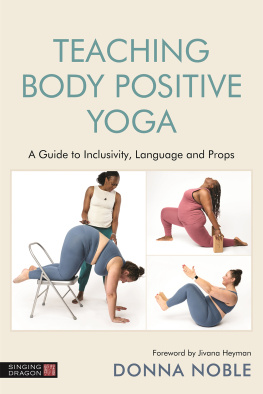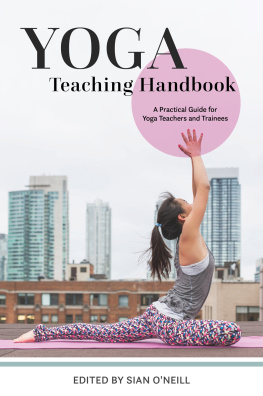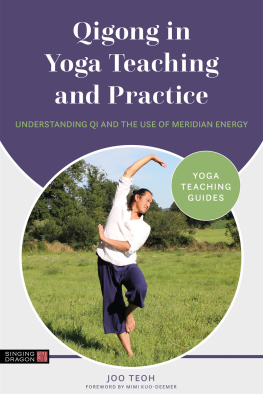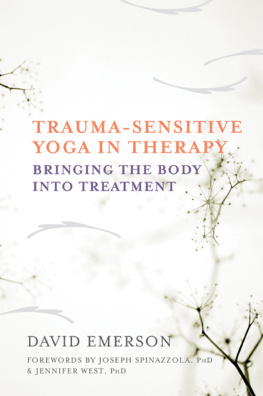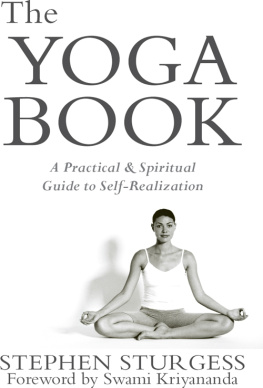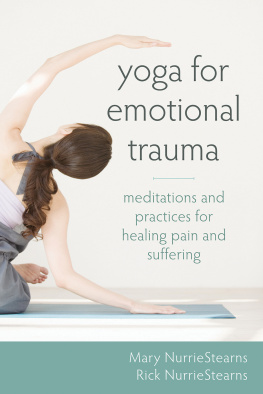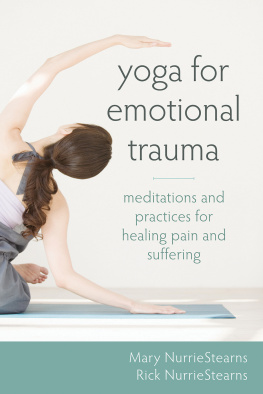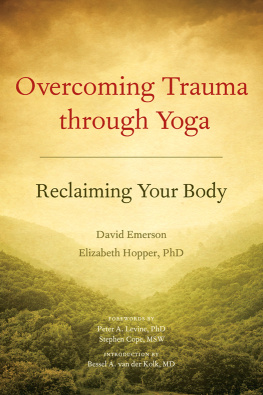
Copyright 2018 by Brendon Abram. All rights reserved. No portion of this book, except for brief review, may be reproduced, stored in a retrieval system, or transmitted in any form or by any meanselectronic, mechanical, photocopying, recording, or otherwisewithout the written permission of the publisher. For information contact North Atlantic Books.
Published by
North Atlantic Books
Berkeley, California
Cover art iStockphoto.com/GelatoPlus
Cover design by Daniel Tesser
Interior design by Happenstance Type-O-Rama
Printed in the United States of America
MEDICAL DISCLAIMER: The following information is intended for general information purposes only. Individuals should always see their health care provider before administering any suggestions made in this book. Any application of the material set forth in the following pages is at the readers discretion and is his or her sole responsibility.
Teaching Trauma-Sensitive Yoga: A Practical Guide is sponsored and published by the Society for the Study of Native Arts and Sciences (dba North Atlantic Books), an educational nonprofit based in Berkeley, California, that collaborates with partners to develop cross-cultural perspectives, nurture holistic views of art, science, the humanities, and healing, and seed personal and global transformation by publishing work on the relationship of body, spirit, and nature.
North Atlantic Books publications are available through most bookstores. For further information, visit our website at www.northatlanticbooks.com or call 800-733-3000.
Library of Congress Cataloging-in-Publication data is available from the publisher upon request.
North Atlantic Books is committed to the protection of our environment. We partner with FSC-certified printers using soy-based inks and print on recycled paper whenever possible
To Colin, the soldier who set me on this path. You are my inspiration, you are my motivation, and you are my hope.
Foreword by Mark Stephens
I n Shakespeares Hamlet, Polonius quipped that brevity is the soul of wit. It can also be the heart of clarity, as we find in this succinct yet no less deeply insightful and practical book from Brendon Abram on teaching trauma-sensitive yoga.
When teaching workshops or trainings for yoga teachers, I often ask how many plan to teach prenatal yoga. Typically, about 10 percent of participants raise their hand. Then I ask how many plan to teach public classes, to which nearly everyone readily responds with an affirmative hand. My response is that everyone who teaches public yoga classes will be a prenatal teacher, if only because pregnant students will be in their classes, adding that it is therefore incumbent upon all public yoga teachers to have at least a basic knowledge of common conditions of pregnant students along with at least some understanding of relevant indications, contraindications, risks, and modifications by trimester and in postpartum reintegration.
It is no different with trauma. Trauma is an issue for at least one-third of people in modern society, and many students come to yoga classes with deeply internalized trauma. Yet trauma is rarely or only very obliquely addressed even among most of the very best yoga teacher training programs.
A couple years after I completed my first teacher training in 1995, I started a program to bring yoga into Los Angeles County juvenile institutions. While I had a comfortable basic knowledge of general principles, methods, and techniques for teaching postural yoga, I was utterly unprepared for what I experienced in teaching yoga to incarcerated youth at the height of the LA gang wars, this despite many years of working with gangs on the streets and in the same institutions. My young students were both victims and victimizers, most with emotional issues rooted in early childhood abuse and abandonment and nearly all with a history of substance abuse (indeed, many were born addicted to cocaine). It was only with the guidance and support of dedicated clinical staff that I started to learn how to adapt yoga practices, including asana, pranayama, and meditation, to make yoga accessible and meaningful to these students. As we developed this project into Yoga Inside Foundation and expanded into hundreds of trauma-intensive settings across North America, we learned along the way that with each new setting and condition we had far more to learn.
Fortunately, we now have the considered and distilled experience, knowledge, and wisdom of Abram to offer practical guidance to those stepping into the intensity of serving students whose every breath, thought, and movement is affected by traumatic experience, including an increasing number with PTSD.
Abram seems to come to his work in writing about teaching trauma-sensitive yoga with a humble and light-hearted sense of being, but his insights arise from deep personal experience of trauma and its emotional, interpersonal, and social consequences. Abram is a thirty-year veteran of the Canadian Forces who served with the United Nations in El Salvador and NATO in Bosnia, places where the terrors of war and violent social conflict offered up daily traumatic events in the lives of the local population as well as those like Abram sent there to protect them.
Abram grew up with the difficulties of an alcoholic father and a mom who struggled with mental illness. He too became an alcoholic and before finding Alcoholics Anonymous was well on his way to perpetuating the cycle of suffering in his own family. With sobriety came a new lease on life, one informed by a personal understanding of what it is to suffer, and struggle, and then suffer and struggle some more. From this personal experience, he also became sensitive to the suffering of others, and he discovered yoga.
In the latter years of Abrams military career, when soldiers started coming back from Afghanistan, he saw the horrible effects that PTSD was having on them and their families. It struck deep to the bottom of his heart. There was one young soldier in particular, Colinto whom he dedicated this bookin whom he took special interest. He taught Abram a really important lesson: that we can never fix another person, but only (and inestimably importantly) show them the tools and help set the conditions for them to do their own work. Embracing this idea, and now into a personal yoga practice, Brendon expanded his knowledge of trauma and trauma-sensitive yoga through workshops with David Emerson and Daniel Libby as well as through collaboration with a student in one of his yoga classes who invited him to work with her to incorporate mindfulness into her clinical practice.
Through his devotion to this work, Brendon started teaching workshops on trauma-sensitive yoga, then wrote a study manual for these workshops, leading to the timely gift of this important book that should be read by every yoga teacher who cares about the overall health and well-being of his or her students.
Brendon fully appreciates that the diversity of students conditions and intentions invite teachers to offer appropriately individualized practices, all the more so when ones students are living with trauma. Rather than prescribing a set approach to every student, a central theme of this book is that each unique student should feel safe and comfortable in doing yoga, further underlining the sensibility that yoga teachers are more guides and facilitators than authoritative sources of transmission. In providing guidance in this way, Abram gets and conveys that yoga teachers are playing a potentially vital rolea therapeutic rolein helping students to discover the truth of their own being, and with it deeper and lasting inner sources of living with a sense of inner peace and empowerment in their lives.
Next page
